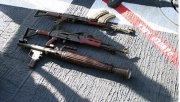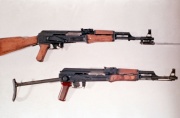Type 56 assault rifle
| |||||||||||||||||||||||||||||||||||||||||||||||||||||||||||
The Type 56 assault rifle is a Chinese copy of the Kalashnikov AK-47 assault rifle, which has been manufactured since 1956. It was produced by state factory 66 from 1956-73, then by Norinco from 1973 onwards. Originally, the Type 56 was a direct copy of the AK-47, and featured a milled receiver, but starting in the mid-1960s, the guns were manufactured with stamped receivers much like the Soviet AKM. Visually, most versions of the Type 56 are distinguished from the AK-47 and AKM by the fully-enclosed hooded front sight (all other AK pattern rifles, including those made in Russia, have a partially open front sight). Many versions also feature a folding bayonet attached to the barrel just aft of the muzzle.
The Type 81 replaced the Type 56 in PLA service during the 1980s but the Type 56 remains in production by Norinco for export customers.
The Type 56 is likely the most widely proliferated AK-47 type rifle in the world having shown up on battlefields in Asia, Africa, Eastern Europe, South America, etc. While exact production figures are not known, it is commonly estimated that as many as 10-15 million Type 56 rifles have been produced since the 1950s which means they may account for nearly one-fifth of the world's AK production.
Contents[hide] |
[edit] Service History
The Chinese Type 56 was the standard issue assault rifle of the Chinese military from the late 1950s until the 1980s when it was replaced by the newer Type 81 assault rifle. Some Chinese Reserve and Militia units still use the Type 56 rifle as well as the SKS. During the Cold War period, the Type 56 was exported to communist forces in the Third World. Many of these rifles found their way to battlefields in Africa, South-East Asia, and the Middle East during the Cold War era and were used alongside Kalashnikov rifles from both the Soviet Union and the Warsaw Pact nations of Eastern Europe.
Chinese support for the Democratic Republic of Vietnam before the mid-1960s meant that the Type 56 was frequently encountered by American soldiers during the Vietnam War, in the hands of either NVA soldiers or Viet Cong guerrillas. In fact, the Type 56 was discovered in enemy hands far more often than Russian-made AK-47s or AKMs. When relations between China and the North Vietnam government declined in the 1970s and the Sino-Vietnamese War began, the Vietnamese government still had large numbers of Type 56 rifles in its arsenals while the People's Liberation Army still used the Type 56 as its standard weapon. Thus, Chinese and Vietnamese forces fought each other using the same Chinese-made Type 56 rifles.

The Chinese Type 56 assault rifle saw considerable action in the hands of Iranian forces during the Iran–Iraq War of the 1980s with Iran purchasing large quantities of weapons from China for their war against Iraq. During the war, Iraq purchased a small quantity of Type 56 assault rifles from China despite Iraq being a major recipient of Soviet weapons and assistance during the Iran–Iraq War. Consequently, the Iran–Iraq War became another conflict in which both sides used the Type 56, much like the Sino-Vietnamese War.
Since the end of the Cold War, the Type 56 has been used in many conflicts across the world by the military forces of various nations. During the Croatian War of Independence and the Yugoslav Wars, the Type 56 was used by the armed forces of Croatia alongside other small arms and weapons the Croatians possessed. During the late 1990s, the Kosovo Liberation Army in Kosovo were also major users of the Type 56, with the vast majority of the weapons originating from Albania, which received Chinese support during the Cold War.
In recent times, the Type 56 has been used by the Janjaweed in the Darfur region of Sudan with pictures and news footage showing members of the Janjaweed carrying Type 56 rifles (most of them, provided by the Sudanese government); the same weapon is listed in the "Products" pages of the Military Industry Corporation of Sudan website as the MAZ rifle, hinting that Sudan may be manufacturing the rifle locally although this is not confirmed by other sources. The Type 56 has also been seen regularly in the hands of militants from the Izz ad-Din al-Qassam Brigades, the armed wing of Hamas in the Palestinian territories; these weapons are most likely provided by Iran, which is both a known supporter of Hamas and a major consumer of Chinese weaponry.
In the mid-1980s, Sri Lanka started to replace their old British L1A1 Self-Loading Rifles (SLR) and HK G3s with the Type 56. Currently, they use the fixed stock, under-folding stock and sideways folding stock variants.
In the United States and the United Kingdom, the Type 56 and its' derivatives are frequently used in the filming of movies and television shows, standing in for Russian-made AK-47's due to the rarity of genuine AK-47 rifles, some even being visually modified to resemble other AK-series rifles, such as AK-74 rifles in the James Bond film GoldenEye. As with all firearms used in cinematography, these weapons are adapted to fire blank ammunition.
[edit] Type 56 variants
- Type 56 – Basic variant introduced in 1956. Chinese copy of AK-47 with fixed wooden stock and permanently attached spike bayonet. Beginning in the mid-1960s, the guns were manufactured with stamped receivers, mimicking the improved (and cheaper) Russian AKM, while the permanently attached bayonet became optional.
- Type 56-I – Copy of the AKS-47, with an under-folding steel shoulder stock and the bayonet removed. Like the original Type 56, milled receivers were replaced by stamped receivers in the mid-1960s, which made the Type 56-1 an equivalent to the Russian AKMS.
- Type 56-II – Improved variant introduced in 1980, with a side-folding stock. Export only.
- Type 56C (QBZ56C) – Shortened barrel version introduced in 1991 for domestic and export market. The QBZ56C began development in 1988, shortly after it was discovered that Type 81 assault rifle was too difficult to shorten. The QBZ56C as it is officially designated in China, is a shortened, carbine variant of the Type 56-II. The barrel length has been reduced to 280mm and the overall length of the rifle has been reduced to 557mm long with the stock folded and 764mm long with the stock extended. The QBZ56C weighs only 2.85kg and has an effective range of up to 300m. The QBZ56C is in active service with the People's Liberation Army Navy on both surface and submersible ships and with the People's Liberation Army Special Operations Forces,the terms and particularly those stationed in Tibet, as the thinner air in higher altitudes creates great stress on peoples lungs and strains their ability to carry heavy objects.[1]
- Type 56S or Type 56 Sporter – civilian version with only semiautomatic mode[2]
- Type 84S - A Civilian version of the Type 56 rifle chambered for the 5.56x45mm NATO round.
[edit] KL-7.62
The Iranian state arms conglomerate Defense Industries Organization (DIO) currently manufactures a 7.62x39mm Kalashnikov-type assault rifle for the Iranian armed forces, which is designated KL-7.62[3]. The KL-7.62 is an unlicensed, reverse-engineered copy of the Chinese Type 56 rifles which Iran purchased from the Chinese government in enormous numbers to equip its forces in the Iran–Iraq War. The original version of the KL-7.62 was indistinguishable from the Type 56, but in recent years, DIO appears to have made some improvements to the Type 56 design, adding a plastic stock and hand guards (rather than wood) and a ribbed receiver cover (featured on most AKM variants, but missing from the Type 56).
[edit] Type 56 carbine
The "Type 56" designation was also used for Chinese version of the SKS, known as the Type 56 carbine, but the designs are entirely distinct.
[edit] Users
- Afghanistan
- Albania
- People's Republic of China
- Bangladesh: Under license by Bangladesh Ordnance Factory[4]
- Bosnia
- Burma
- Cambodia
- Croatia
- Ethiopia
- Finland: Wartime stocks only[5]
- Hamas
- India
- Iran
- Iraq
- Janjaweed
- Laos
- Liberation Tigers of Tamil Eelam
- Malta
- Nicaragua
- Pakistan
- Sri Lanka
- Sudan: Licensed made as the MAZ[6]
- Taliban
- Vietnam
[edit] Resources
| Gun Owners' Resource has the following relevant documents available for free download for the Type 56 assault rifle and/or its variants: |
- 84S Series 5.56mm Semi-Automatic Rifle Instruction Manual (9 pages, 795KB .pdf file)

This article is either missing some diagrams which would help to illustrate a proper breakdown of the firearm in question or the diagrams which are here are inadequate. This article could use more input to fill in the missing bits. You (yes, you!) can help Gunsopedia provide more comprehensive information to our users by using your own knowledge to add to it.
[edit] See also
[edit] References
- ↑ 详解中国首款QBZ56C型短突击步枪(组图) Sina.com (Simplified Chinese) 2007-08-28
- ↑ Norinco
- ↑ KL-7.62 photo.
- ↑ Type 56 Submachine Gun.
- ↑ 7.62 rynnäkkökivääri 56 TP www.mil.fi
- ↑ MAZ Military Industry Corporation (Sudan)
[edit] External links
- Sino Defence
- Modern Firearms
- 56 at IMFDB - detailing this weapon's use in Western cinema
| [hide]"Type 56 assault rifle" is part of a series on the AK-47 and its cousins |
|---|


